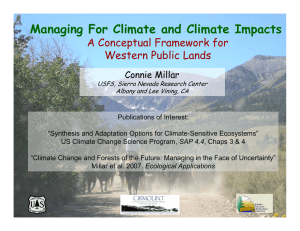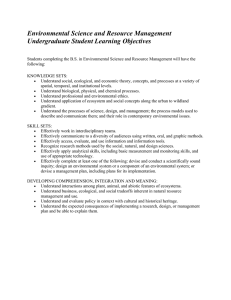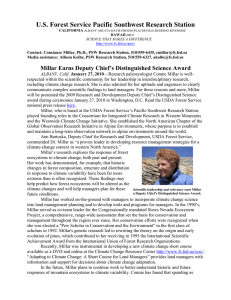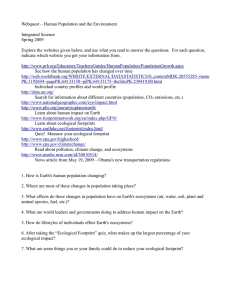Document 13544043
advertisement
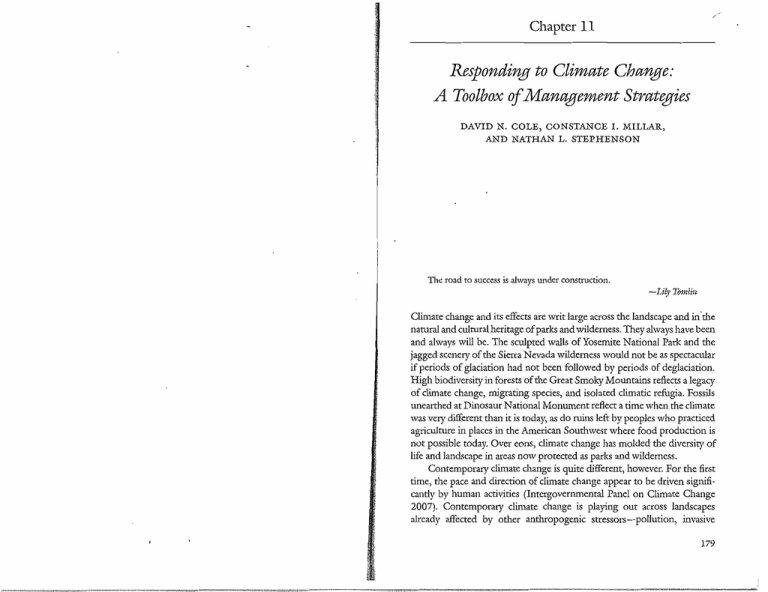
/
Chapter 11
Responding to Climate Change:
A Toolbox ofManagement Strategies
DAVID N. COLE, CONSTANCE 1. MILLAR,
AND NATHAN L. STEPHENSON
The road to success is always under construction.
-Lily Tomlin
Climate change and its effects are writ large across the landscape and in'the
natural and cultural heritage ofparks and wilderness. They always have been
and always will be. The sculpted walls of Yosemite National Park and the
jagged scenery of the Sierra Nevada wilderness would not be as spectacular
if periods of glaciation had not been followed by periods of deglaciation.
High biodiversity in forests ofthe Great Smoky Mountains reflects a legacy
of climate change, migrating species, and isolated climatic refugia. Fossils
unearthed at Dinosaur National Monument reflect a time when the climate
was very different than it is today, as do ruins left by peoples who practiced
agriculture in places in the American Southwest where food production is
not possible today. Over eons, climate change has molded the diversity of
life and landscape in areas now protected as parks and wilderness.
Contemporary climate cllange is quite different, however. For the first
time) the pace and direction of climate change appear to be driven signifi­
cantly by human activities (Intergovernmental Panel on Climate Change
2007). Contemporary climate change is playing out across landscapes
already affected by otller anthropogenic stressors - pollution, invasive
179
180
Responding to Climate Change: A Toolbox of Management Strategies
MANAGEMENT STRATEGIES FOR IMPLEMENTING NEW APPROACHES
species, altered disturbance regimes, and land fragmentation. COlnpared to
landscapes with continuous habitat, fragmented landscapes severely dimin­
ish the ability of species to·respond adaptively to rapid climate change.
Contemporary climate change therefore places much that humans value
';at risk. Biodiversity is threatened, as are precious park landscapes. The gla­
ciers in Glacier National Park are projected to disappear by 2030 (Hall and
:Fagre 2003). Models suggest that climate change may make it impossible
for Joshua trees (Yucca hrevifilia) to persist in Joshua Tree National Parle
(Cole et al. 2005). Rising sea level threatens the freshwater wetlands of
Everglades National Parle Increasingly severe drought, earlier snowmelt,
reduced stream flows, larger and more intense fires, and widespread insect
and disease infestations portend a future ofdiminished park aIld wilderness
values, both social and ecological (Saunders et al. 2007).
The first step in responding to climate change is to clarify protected
area goals and purposes. A prominent theme in this book has been the need
.to move beyond the singlliar traditional goal of sustaining naturalness and
articulate diverse forward-looking goals more helpful in guiding when and
how to intervene in ecosystems. Beyond this, there is an immediate need to
b,egin planning for and respon~g to climate change. Some actions can be
~aleen in the near term; others will bear fruit only in the future. Some actions
can be implemented locally; others will be successful only when played out
over large landscapes. In tllls 'chapter, we describe a toolbox of potential
maIlagement responses to climate change. We begin with a general man­
agement framework) move to more specific near-term, local management
actions, and conclude with longer-term, larger-scale approaches. Dealing
with uncertainty-acknowledging it, taking action despite it, learning, and
responding appropriately when surprises occur-is a central thenle of the
chapter.
,
,
,
:
Management Approaches in the Context of Climate Change
One of the actions protected area managers can take irnnlediately is to
incorporate climate change into existing management plaIls (Heller and
Zavaleta 2009). Several frameworks for doing tllls have been proposed.
}vIost involve articulating goals, identifYing key ecosystem elements and
processes) identifYing indicators, setting baselines or limits of acceptable
variation, assessing vulnerabilities and sensitivities, establishing monitor­
ing programs, and identifYing appropriate adaptive responses to climate
change (Spittlehouse and Stewart 2003; Baron et al. 2008; Kareiva et al.
181
2008; Heller aIld Zavaleta 2009). For example, the National Park Service
prepares a foundation plan as part of tlleir general management plan. The
Forest Service prepares a comprehensive evaluation report as part of their
land management planning process. These documents focus on patterns
and trends in environmental conditions, emerging stresses, and anticipated
changes. Scenario planning exercises relevant to climate change (described
in detail in Chapter 13) can be incorporated into strategic visions and
frameworks that contribute to final plans.
The four management enlphases explored in the second part of this
book, autonomous nature, historical fidelity, ecological integrity, aIld resil­
ience, represent a range of protected area goals Witll different management
strategies. Where autonomous nature is the goal, th,e response to climate
change is to not ffiaIlipulate ecosystems. In contrast, to maintain a high
degree of historical fidelity, intensive and frequent 111anipulation of eco­
systems, llluch of it at localized and small scales, is often necessary. For
example, Tuolumne Meadows in Yosemite National Park luight be sus­
tained as tlle largest subalpine meadow in tlle Sierra Nevada, offering tlle
sanle stwming views in upconllng centuries as it has in the past. But this
will probably require continual reillova! of lodgepole pine (Pinus contmta)
seedlings and saplings tllat invade tlle meadow with increased frequency as
climate changes, and possibly even irrigation to maintain species intolerant
of drier conditions.
Ecological integrity and resilience are managenlellt goals tllat are in
several ways intermediate between autonomous nature and historical fidel­
ity. They imply active intervention to conserve elements of biodiversity,
as managing for historical fidelity does, but are generally implenlcnted at
lower intensities and larger spatial scales I tllan efforts to sustain historical
fidelity. For example, with ecological integrity or resilience as a goal, lodge­
pole pine might be allowed to invade Tuolunme Meadows. Interventions
luight focus on ensuring that hydrologic regimes remain ftmctional aIld the
regional population viability of meadow species is not tllreatened.
If they are to intervene, managers must decide whether to be proactive,
anticipate change and act in advance, or ~o respond only after disturbance
or extreme events. Waiting to respond might reflect uncertainty regarding
the need for action or what actions are likely to succeed. Waiting might re­
flect a precautionary approach and be preferred by risk-averse actors (Heller
and Zavaleta 2009). Alternatively, waiting might reflect a decision that the
best time for action, from a scientific or an orgaIlizational efficiency stand­
point, is after disturbance. Regardless, what is important is to plan allead,
so responses can be quickly implemented when windows of opportunity
182
MANAGEMENT STRATEGIES FOR IMPLEMENTING NEW APPROACHES
open (Joyce et aI. 2008). For instance~ in the Rock Creek Butte Research
Natural Area, California, the entire population of rare Brewer spruce (Pi­
cea braveriana) burned during a 2008 wildfire. Climate envelope modeling
for this species suggests that there will no longer be favorable habitat for
Brewer spruce in the future of California, and dlerefore restoration is not
appropriate. However, after a fire is the best time to attempt regeneration
and establish a refugium for Brewer spruce in its current native habitat.
Proaccive~ anticipatory responses use "current information about fu­
~ ture climate, future environmental conditions and dle future context" of
protected area management "to begin making changes to policy and on­
the-growld management now and when future windows of opportunity
open" (Joyce et al. 2008: 3-40). The ability of climate science to make
projections about future climate and resultant changes in biota has im­
proved (Intergovernmental Panel on Cfunate Change 2007). However, as
discussed in Chapter 4, the current state of the art suggests it is danger­
ous to commit to projections as accurate forecasts, especially at the scales
relevant to parle managers. Model outputs are better viewed as vehicles for
organizing thinking, considering different scenarios, and gaining insight
into a range of possible futures (Millar et al. 2007).
Adapting to Climate Change
Regardless of whether actions are taken reactively or proactively, the ulti­
mate goal is to help ecosystems, ecological elements, and processes adapt
to climate clIange and accOlnplish dUs by increasing the adaptive capacity of
protected area policies and institutions. l'viany ways of adapting have been
suggested, but most recomnlendations are still at the idea stage (Heller and
Zavaleta 2009). Most are general rather than specific and actionable, based
more on logical dunking than empirical data. This is particularly true for
protected areas, where many specific recommendations (thinning forests,
creating more diverse stand sttuctures, realigning ecosystems, moving spe­
cies) are potentially so intrusive and heavy-handed to seem anathema to tra­
ditional thinking about what is appropriate in wilderness and some parks.
That is why this book emphasizes the need to rethink protected area goals
and carefully evaluate whether proposed management actions advance or
detract from goal achievement.
Some suggestions focus on ecological interventions, whereas odlers fo­
cus on societal issues, policy, and institutional change. Reconunendations
vary in the temporal and spatial context of application. In this section we
Responding to Climate Change: A Toolbox of1Ylanagement Strategies
183
first explore actions that can be taken in the near term by managers of indi­
vidual parks and wildernesses. Then we turn to actions that take more time
to implement and must be used at large spatial scales.
Near-Tenn Aaionsfor Local Managers
We begin with near-term actions designed to protect ecosystems, buffer­
ing them from effects of climate change and helping them resist change.
Ecosystems, their elements and processes~ must respond to climate change
by adapting in place, or species m115t migrate sOll1eplace else; othenvise
they go extinct. AldI0Ugh resistance to change may seem a denial of nlulre
change, it is a defensible approach to LU1certainty, particularly for highly
valued attributes such as endangered or iconic species. Increasing resistance
is also a means of buying time. A number of traditional stewardship actions
will promote resistance. Managers can promote basic ecosystem function­
ing and mitigate threats to resources (Heller and Zavalcta 2009). Actions
might include more aggressive management of adverse effects posed by
invasive species, recreational use, livestock grazing, or water diversion. For
instance, groundwater pumping for rural municipal use or for recreational
developments such as ski areas can deplete 1110Ul1tain aquifers, causing
springs, fens, and wetlands to dry up. Negotiated cOlnpromise and en­
hanced water conservation Dlay reduce water demand.
Maintaining natural disturbance dynamics is anodlcr common recom­
mendation (Taylor and Figgis 2007), but this option exposes the conflict
between actions that create resistance to change and those tlIat promote
adaptive capacity or resilience. For example, climate change is expected
to increase fire frequency and intensity, a change already being obseryed
(Westerling et al. 2006). Suppressing unusually severe fires, particularly
those that threaten highly valued ecosystem elements, such as old-growth
forests, is a means of resisting changes wrought by c1i1l1ate~ but dlis is often
not possible. 1vloreover, doing so ignores the fact that many biotic elements
need fire for dIeir persistence. Intervening in fire processes interferes with
an important mechanism by which vegetation adjusts to new climatic con­
ditions. As Noss (2001: 585) suggests, "a mixed strategy in which nlanag­
ers let many natural fires burn, protect (to the extent possible) old growth
from stand-replacing fires, and manage adler stands by prescribed burning
and understory thimung to reduce the risk ofhigh-intensity fire, ilIay be the
optimal approach?' Indeed dIe very concept of natural disutrballce is evolv­
ing as changing climate brings fire and insect outbreaks to places dlat have
184
MANAGEMENT STRATEGIES FOR IMPLEMENTING NEW APPROACHES
not experienced them for centuries, at larger spatial scales and at different
times ofthe year than in the past.
Over paleohistorical time scales, climate has acted as a driver of biotic
change, with much ofthat change occurring synchronously across the land­
scape (Betancourt et aI. 2004). At decadal and centennial scales, for example,
windstorms in the eastern United States and drought in the West have at
times synchronized forest composition and stlucture across the landscape,
possibly making them more vulnerable to climatic shifts. A recent example
may be the extensive dieback in sonle forests as a result of drought (Bres­
hears et aI. 2005). This has led some to suggest that vulnerability to climate
change might be reduced by deliberate reduction of landscape synchrony
(Millar and Woolfenden 1999; Betancourt et aI. 2004). Actions that pro­
mote diverse age classes, species mixes, and landscape structural and genetic
diversity reduce landscape synchrony. This can be done most effectively at
early successional stages, when ecological trajectories are influenced more
by present and future climatic conditions than by those of the past (Millar
et al. 2007).
Peters and Darling (1985) suggest it Inay sometiines be necessary to
undertake heroic rescue efforts, for example by irrigating sensitive species.
This nlight be one response to the potential loss of Joshua trees (Yucaa
breviftlia) in Joshua Tree National Parle Other examples include using at­
tractants to lure songbirds to continue to use specific meadows, provid­
ing winter forage during harsh years for endangered species, or provid­
ing supplemental forage to encourage dispersal along planned corridors.
Such projects illustrate the degree to which enhancing resistance in the face
of directional climate change is alan to paddling upstream (Millar et al.
2007). They require ever-increasing effort) of a nature so intensive as to
often be deemed undesirable, particularly in wilderness. Moreover, if con­
ditions change enough, all but dle most localized and intensive efforts may
be futile. Ecosystems are likely to cross thresholds and be lost, perhaps with
catastrophic consequences (Harris et al. 2006). Considering tIus, Millar et
al. (2007) conclude that resistance options are best applied for dle short
term, to buy time, and where values at risk are high or sensitivity to climate
change is low.
Complementary to enhancing resistance is facilitating the ability of
ecosystems to adapt to climate change. Some options involve increasing
capacity to adap,r in place; others involve facilitating migration. Where eco­
systems have been significantly disturbed, restoration treatments are often
prescribed. Radler than restoring ecosystems to historical predisturbance
conditions, managers increase adaptive capacity by realigning ecosystems
Responding to Climate Change: A Toolbox of Management Strategies
185
with current and future conditions. Examples include restoration of fire
regimes altered by fire suppression or ofstream or meadow hydrologic rela­
tions altered by water impoundments, diversions, or livestock grazing. In
situations where there is substantial confidence in predictions about future
conditions, management interventions can be narrowly targeted. Fires Inay
need to burn nlore frequently or during llifferent seasons than in the recent
past. Managers may want to encourage compositional shifts toward more
drought-tolerant species where meadows have been altered by grazing or
water diversion. More conm10nly, 'where the future is quite lillprcdictable,
it might be best to realign ecosystems with a range ofpossible future condi­
tions, for example using a broad species mi.-x rather than a mix targeted to
past conditions.
Traditional genetic management guidelines aim to avoid contamina­
tion of populations with ill-adapted genotypes by establishing sinall seed
zones and dictating that seeds (or other plant materials) used for resto­
ration come from small, local zones. This restriction on genetic diversity
made sense under the assumption dlat enVir01ll11ents and climates were
stable. But relaxing genetic guidelines, for both plants and animals, using
germplasm from a wider geographic area and diversity of populations, .
lnakes more sense given climatic change (Ledig and IGtzlluller 1992). i\:1an­
agel'S might use predictions that future clin1ates will be warnler to empha­
size germplasm from warmer (often downhill) populations. Alternatively,
tl1ey might hedge their bets by enlarging seed zones in all directions (Joyce
et al. 2008). Best genetic management practices also enlphasize equalizing
germplasm contributions and enhancing population sizes by ma.ximizing
the number of parents and striving for equal anlounts of plant material
from each parent. These guidelines become especially inlportant in an un­
certain future.
Species unable to adapt in place Inust move. To migrate successfully,
species need viable source populations and habitats, appropriate destina­
tions, and a way to get from source to destination (Taylor and Figgis 2007).
l\.,fanagers can assist by identifYing and conserving refugia, envirol1lnents
that are buffered against climate change and odler disturbances. Refugia
provide places where a species might persist even if unfavorable condi­
tions cause it to disappear elsewhere. Refugia can be important sources and
destinations. Past climatic refugia can be identified. For example, mOUll­
tainous landscapes have highly heterogeneous environments, Witll diverse
microclimates, §.ome of wluch (particularly cool and nlesic sites) can act
as refugia. Later in this chapter we describe a case in which nlanagers are
reorienting goals to optimize an area's value as a climatic refugium. Once
186
MANAGEMENT STRATEGIES FOR IMPLEMENTING NEW APPROACHES
identified, refugia and the populations they harbor become high priorities
for protection.
Species movement can be facilitated by allowing migration. As rates
of species movement increase in response to change, traditional notions
of a species range will be challenged, and the line between native and non­
native species will blur, as will the definition of an invasive species (Millar
and Brubaker 2006). Managers will need to decide whether invasions are
beneficial or adverse and manage accordingly. Managers may even manipu­
late environments to encourage migration, thilrning forests, for exanlple,
to encourage species that establish and grow better with more light and less
conlpetition.
More controversial is assisted migration, actively helping propagules
or individuals move to new habitats where they are presumably better
adapted. Assisted migration has sparked much interest and debate. Trans­
locations are often unsuccessful, and unanticipated consequences can result
frOln introducing new species into extant communities (Heller and Zavaleta
2009). Hoegh-Guldberg et al. (2008) propose a framework for deciding
where assisted migration seems necessary and feasible and where other op~
tions are preferred. McLachlan et al. (2006) argue that there is an urgent
need for debate and policy development regarding assisted migration. To
start the process, these authors identity major policy choices, articulate iln­
plications of each choice, and provide a research agenda to inform debate
and decision.
The final option is ex situ protection ofthe species most threatened by
climate change, where this is the only option short of extinction. Species
could be preserved in zoos and botanical gardens in the hopes that a tilne
will come when the effects of climate change can be reversed and species
can be returned to their native landscapes (Noss 2001).
Longer-Term) La1ZJcr-Scale Actions
As noted earlier, many near-term actions that local prote,cted area manag­
ers might tal<e are likely to be controversial, involving intensive and ma­
nipulative actions, often undertaken Wlder conditions of high uncertainty.
Perhaps less controversial, probably more important, but more difficult to
implement are actions that must be taken at large spatial scales and played
out over long timeffames. Chapters 12 and 13, on conservation at large
spatial scales and building more adaptability into planning, cover some of
Responding to Climate Change: A Toolbox of Managcment Strategies
187
tills same nlaterial. Consequendy, discussions here are brief and more sug­
gestive than definitive.
One challenge to protected area management is that species move but
protected area boundaries are fi"Xed. This has long been a problem where
protected areas are small and when arulnal popUlations migrate. Climate
change will exacerbate this probleln. The obvious response is to plan for
conservation at much larger scales, enlarging the effective size of presenrcs
and reducing limitations associated with their finite locations in space.
There are several ways regional and landscape planning can inlprove adap­
tation to climate change.
Because species have to move, an ob\'iol1s goal is to promote landscape
connectivity (Noss 2001). Plants (and many animals) move by dying out in
places that are no longer hospitable and colonizing nevvly habitable places.
These migrations are inhibited to the degree dlat landscapes are fragmented
and encouraged by the connectivity of the landscape. Landscapes with con­
tinuous habitat and few physical or biotic impedinlents to migration pro­
vide good connectivity (Millar and Brubaker 2006). Fragmentation can be
avoided (e.g., by limiting roads)~ and connectivity can be promoted (e.g.,
by providing underpasses where there are roads) within large protected
areas. But if the biotic shifts associated with climate change are substantial~
connectivity must extend beyond individual protected areas to networks
of protected areas and to the lands that constitute the matrix in which pro­
tected areas are situated. As disclUlsed further in Chapter 12, this has led
to proposals that core protected areas be linked by corridors to facilitate
movement and exchange (see Noss et al. 1999, for example) and proposals
for continental-scale corridors and linkages.
Connectivity can be promoted in many ways at various scales. Examples
include situating trails in parks where they will have Ininilnal connectivity
impacts on small rodents and lagomorphs and building campsites \vhere
they will not interrupt migration routes of large Inanlmals. Similarly, veg­
etation can be managed to maintain wlinlpaired \vildlife movement. For
exmuple, prescribed fire has been used in the Sierra Nevada to reduce hid­
ing cover for mountain lions (Felis concolor), the presence of which inhib­
ited movement of Sierra bighorn sheep (OlJis canadensis sierrae) upslope to
cooler, moister summer habitat.
A related action involves managing the lllatrix, the lands around and
between protected areas that are not designated for protection but increas­
ingly influence the integrity of parks and wilderness. The nlatri"X can be a
source of threats, especially if some lands harbor invasive species or gener­
188
MANAGEMENT STRATEGIES FOR IMPLEMENTING NEW APPROACHES
ate pollution. The matrix can be fragmented and pose significant barriers
to connectivity. Ideally, conservation in the matrix would "soften" land use
by encouraging less damaging practices, such as practicing low-intensity
forestry rather than clearcutting (Heller and Zavaleta 2009). Barriers to this
strategy are substantial because many landowners and mangers have goals
quite different from those of nearby protected areas, often emphasizing
development and commodity extraction. Matrix lands are often owned by
other government agencies or are private lands. Collaboration and identi­
fication of shared goals are needed, as are innovative mechanisms such as
conservation easements and conservation futures (Hannah et al. 2002).
Regional planning is critical to promoting diversity and redwldancy
in management strategies as a means of nlanaging risk associated with the
uncertainties associated with climate change, its biotic effects, and the ef­
fectiveness of responses to change. Diversificatio~ is a means of hedging
bets (Hummel et ai. 2008), not putting all one's eggs in the same bas­
ket (Millar et al. 2007), and increasing adaptive capacity. Returning to the
goals of Part II, the likelihood of optimizing all protected area values is in-"
creased if varied goals and strategies are used in different protected areas or
different parts of large protected areas. This diversified approach increases
the likelihood that if one strategy fails, a different strategy lnight succeed
elsewhere. The complement of diversity, redundancy, is equally important.
Diverse management strategies should be replicated across diverse environ­
ments. Again, if they fail in one place, they might succeed elsewhere. En­
suring plaImed, purposeful diversity and redundancy entails regional-scale
planning.
The challenge of coordinated planning beyond the boundaries of pro­
tected areas and among networks of protected areas suggests the need for
innovation. New goals lnust be articulated. These goals should be diverse,
rather than monolithic, if they are to capture the array of protected area
purposes and values. In many situations, goals may focus more on func­
tion or process than on composition and structure (Millar and Bnlbalcer
2006). They may focus on species persistence in large geographic areas, re­
laxing expectations that current species ranges will remain constant or that
population abundances, distributions, and species composition will remain
stable (Millar et al. 2007). Seastedt et al. (2008) note that it may be better
to manipulate mechanislns that enhance desirable system components than
to remove or suppress undesirable components. A broader range ofecosys­
tem types may be considered desirable (Heller aIld Zavaleta 2009). Rather
than target a single desired future condition, goals might shift to avoiding
a range oflmdesirable conditions (Joyce et al. 2008).
Responding to Climate Change: A Toolbox of Management Stfa.tegies
189
Managers must anticipate, confront, and incorporate uncertainty and
the likelihood of surprise into planning aI1d nlaI1agement. They must ac­
cept that climate change is likely to push populations beyond thresholds of
mortality (Millar et al. 2007), sometimes to highly degraded states, and of­
ten to conditions for which there is no analog today or in the past (Harris et
a1. 2006). vVhere managers can control ecological processes to a substantial
degree, adaptive management is an effective means of dealing with uncer­
tainty. Discussed at length in Chapter 13, adaptive management involves
learning by doing. 1vlanagers design actions that test uncertainties, monitor
results, learn, and adjust practices accordingly.
vVhere uncertainty is high aIId 111a.nagerial control is limited, scenario
planning is a useful tool (Peterson et al. 2003). Scenario planning involves
articulating and exploring a wide set of alternative futures, each of which
is plausible but uncertain. Scenarios provide a mechanism for anticipating
and working through conflicts between goals. Contingency plans can be
developed for observable undesirable trends that are likely to continue and
for catastrophic events with a low probability of occurrence (Baron et al.
2008).
Conflict, trade-offs, uncertainty) aIld lin1ited resources suggest the
need to prioritize and practice triage. Goals must be prioritized, as must
the ecological elenlents and processes lnanagers seek to sustain. Regarding
the protection of selected elements or prioritizing of specific n1a.nagelnent
situations, a triage approach might be helpful (Hobbs et al. 2003). In a
resource conteA'L, triage involves systen1atica.lly sorting different situations
on the basis of urgency, sensitivity, and capacity of available resources to
achieve desired outcomes (Millar et al. 2007). Categories range from situa­
tions with high urgency, adequate resources, and a proposed treatment dlat
is likely to be effective (treat imnlediately) to siulations dlat are tllltreatable,
regardless of urgency, because of inadequate resources, catastrophic degra­
dation, or no viable treatment.
Most of the actions discussed here-fronl planning for diversity aIld
redundancy to prioritization and triage-are best done at scales that ex­
tend far ~beyond the boundaries of individuat protected areas. This raises
the need for institutional change to improve regional coordination d1rough
increased interagency cooperation and cooperation betvveen different field
units in the same agency. As discussed in Chapter 12) it is imperative to
develop the institutional capacity to produce regional visions and strate­
gies so that local decisions made by managers of individual protected areas
add to the diversity, redundancy, a.nd capacity of regional systems. This will
be challenging given the decentralized decision-making tradition of public
I
t
190
MANAGEMENT STRATEGIES FOR IMPLEMENTING NEW APPROACHES
Responding to Climate Change: A Toolbox of lvlanagemc11t Strategies
191
land agencies and traditional lack of cooperation between agencies and be­
tween public and private lands.
Equally important are efforts to change policies and institutions to en­
hance flexibility and the capacity to adapt through learning. To confront
uncertainty and avoid paralysis, appropriate risk taking must be encour­
aged. "Safe to fail}} strategies intend to succeed but recognize the potential
for failure. Punishing managers who prudently accept risk but ultimately
fail will malce all managers so risk averse that proactive actions that are
needed will never be talcen (Baron et al. 2008). Although never desired,
failure opens tlle door to learning and whittIing awav at uncertainty. But
to learn frOlTI failure, we must monitor tIle effects of ;ctions, WitIl l~ssons
learned incorporated into future plans. Managers must develop tIle capacity
to reassess conditions frequently and be willing to change course as condi­
tions change. As discussed in Chapter 13, this will require institntions and
policies that eluphasize flexibility rather tIlan highly structured decision
malcing (Millar et al. 2007).
Devil's Postpile National Monument as Clinlatic RefugiuIU:
A Case Study
Despite tIle fact that effects of climate change are already apparent in many
protected areas, few have addressed climate change in a substantial manner.
Devil's Postpile National Monument in California is one unit attempting
to assess implications of climate change for their stewardship program and
even revisit park purposes and goals.
Devil's Postpile is a snlal1 park unit (325 hectares) located at about
2,300 meters elevation, dose to tIle headwaters ofthe San Joaquin River in
the Sierra Nevada. It is adjacent to Forest Service land, much of it wilder­
ness, not far from Yosemite National Park and tlle major destination ski
resort Mammoth Mountain. The monument was created to protect one of
the world's finest examples of highly symmetrical columnar basalt (Figure
1l.1) and is known for its fine mountain scenery. Despite its small size, the
monument is highly diverse, with more tIlan 400 plant species, 100 bird
species, 12 species ofbats, and 35 mammal species. Sonle oftIle reasons for
this biodiversity include the prevalence of wetlands in tlle monmnent (8.5
percent of the park) and its location at a low point in tIle Sierra Divide,
where tI1fee bioregions converge (Central, Soutllern, and Eastern Sierra).
Research suggests tlut the monument luight provide an important
refugium for many species during a period of climate change because of its
Devil's Postpile National Monument was established to protect a
unique geological resource, perhaps the world's finest example of highly symmetri­
cal columnar basalt. In a fumre of rapid climate change, it may help sustain regional
biodiversity by being an important climatic refugium. (Photo by the National Park
Service)
FIGURE ILL
lrnique topographic position. Located in a deep canyon, running noM to
south, tIle monument is subject to substantial pooling of cold air. Projec­
tions suggest tIlat this cold air pool might warnl more slowly than tlle sur­
rOlmding landscape (if it warms at all), buffering the park from predicted
warnling and drying and allowing the park's wetIands to survive longer
than might be the case elsewhere (Lundquist and Cayal1 2007). Managers
of the monument are considering a reorientation of their goals and pur­
poses t,o optiInize the monument's potential as a climatic refugium, an area
that is less affected by climate change than its slllTom1dings.
Monument manager~ are developing a strategy to build on current
programs to increase their capacity to plan for and respond to climate
change. They are attempting to obtain additional resources and staff to
study, monitor, and luanage issues such as climate~ past and present, and its
effects on native species, invasive species, pest outbreaks~ and the need for
restoration. In recognition oftIle need to work at spatial scales much larger
192
Responding to
to Climate
Climate Change:
Change: A
AToolbox
Toolboxof
of1-ianagement
Strategies 193
193
Responding
Management Strategies
MANAGEMENT STRATEGrES
STRATEGIES FOR IMPLEMENTING
IMPLEMENTING NEW
NEW APPROACHES
APPROACHES
than the monument itself, collaborative relationships are being
being developed
developed
with other land management agencies and private entities that own
own or
or manman­
age surrounding lands. Interagency workshops have been held, in
in an
an effort
effort
to ll1anage
is extremely
extremely
manage the Eastern Sierra as more of a unified system. This is
migration corricorri­
important, because the monument functions as a critical migration
its wetlands are sustained
sustained
dol',
dor, connecting lower and higher elevations, and irs
can be adversely
adversely
by waters tllat
dut originate on national forest land and that can
affected by developnlent
development on neighboring private lands.
-",'
--::~,\,
"
.,
Moving Forward in the Face ofUncertainry
of Uncertainty and Change
{
BOX 11.1.. RESPON DING
TO
.
. CLIMATECHANGE
"
.. _.,.
.
..
~'
; ..•. Ma:naging in.the face of climate charj"ge require~ a,toolb.ox of~ppmilFre5,
including. short-term and long-term strategies that focus on ecosystem
'..: resistance and. resilience and' help e,cosystems ~o~Pt,ito~change::;',~>,\,~,
• D.ealing· with 'un.~ertainty is a fundaJUentalc~alt~n'ge.1 bes~~te~lt; With
through increased flexibility and adap~bHity, as w~t.l ~~c:aref4ll'yplal1~ed
. diversity and 'r~dL1ndancy at' multipl~:;~cales. .
.'
• ~~ear,-t~rm: a'ctions managers of individual 'p.r9tect~d< ~!e~,S:.migr~,cp,n~~,q~r
in'elude,the following:·
.
. : ; : '~~::\ ';:.:.;:.:(i. '.
:,
'. Mitigating tbreats to resources
.
,.
.'"
. .. .· ...;Maintai·~ing·natu'ral disturbance dy6ami'cs
.. " . ' ReduCing' landscape synchrony'
,.
.
.', Making :aggressive but thoughtfully prioritized effQrts:~prescue~Ngl1,l:i
,, .
·.1~'~"
sensitive species '
,f~i/t;- ..
Realigninlic~nditions with curr(~t, .·ex~~cted, :ot::aV~h~eof pos,stb,Le
future co'nditions
..
Relaxing
genetic,
guidelines
·where
risk
is
low
and
adaptivemal1age-.
I
: . . ,
.
"
. . . . ,:.,
I ' " ,.J . mentcari ,peimplemented . ,
" ',>,
." :_. ~._"~'~ Conseiv;'og:'re}ugia' ....
'
. ."
; .'
"AlLo~in~gor adively as'sisting migr~tion
'.0., ,
.
' .: : Cautiously. considering' the use of no~naHJe spech!s'wh-ere they ar~the
'~est~oPti~_n:f~r m~;ntaining' criticaLecosystem.func.Sions<,
. :.,'::,</
:.... , Prcite'~ting: highly,' endangered species e~,~itu,
.' •. .Long'e~~tl~rm.i.larger-scale actions include;th~~ifolL8wing: !,"i
"
.. Promoting landsciipeco'nnectivity" ;'i:;;~;)";;.
. '; Managing the matrixf~:~C;;\,
.; \. ~ '.- Pro,mating diversity,and redundancy'
. Articulating new. goals
'. . . "
'.; Incorp~rati~iluncertainty and the likelihOOd, of surpri?~!.l)toi pJ~nning :,', .~iid' man'agement'
. . , . ~" i ,(
c;, ' " ',: . ,
~"
.,.;..:,,:.;"
Climate change is likely to be the defining issue facing managers
nlanagers of
of parks
parks
changes are
are already
already
and wilderness in the twenty-first century. Ecological changes
urgency. But what exacdy
exactly should
should be
be
occurring, and tllere
there is a rising sense of mgency.
tlut local manman­
done? In this chapter, we have described a variety of actions t11at
tllese actions are
are risky.
risky. UnUn­
agers can consider in tlle
term. Many of these
the near term,
certainty is high, and some actions are so intensive and manipulative as
as to
to
seem inappropriate on lands that are supposed to be wild
wild and
and l.UlcontroUed.
lIDcontrolled.
seen1
Less controversial is tlle
the urgent need to change policies and
and institutions
institutions to
to
make them more flexible and adaptive and t11ereby
tllereby increase
increase the
tlle resilience
resilience of
of
ecosystems to climate change.
institutional milieu
milieu that
tl1at is
is necnec­
Millar et al. (2007: 2146) describe the institutional
essary, one that embraces "strategic flexibility, characterized
characterized by
by risk-taking
risk-talci.ng
(including decisions of no action), capacity to reassess conditions fre(induding
fre­
quendy, and willingness to change course as conditions change."
change:) Park
Park and
and
quently,
wilderness goals should be more diverse, both to be responsive to
to varied
varied
probably need
need to
to be
be more
more
park purposes and to reduce risk. Such goals will probably
more tolerant
tolerant of
of
flexible, allowing for a broader array of desirable futures, more
biotic changes resulting from human activity (Welch 2005), and
and couched
couched
more in terms of maintaining regional biodiversity and ecosystem
ecosysteln funcfunc­
and
tion than maintaining contemporary biotic commWlity
conlmunity composition and
structure.
protected area
area
Successful regional planning and collaboration beyond protected
bowldaries will be critical to responding effectively to climate change.
Parks
change. Parks
climate change
change malces
malces
have always been too small to manage in isolation; climate
them that much smaller,
smaller. What are urgently needed are institutions and
and
tllem
tllat enable"planned
enable'planned diversity and redundancy
policies tl1at
redtmdancy in
in goals, strategies,
strategies,
and management practices across large landscapes and promote
pronlote connected
connected
the movement of species,
species.
landscapes to ease tlle
;.
i.
"
I
.:<,',
<
P..noritizing and practicing triage
Increasing interagency cooperation
'. .: i
..
Increasing fiexibiLity and the capacity t,o ad~ptthrqughrl~%~i.i~g
.1
-
~: .
.
.
'
.'
.
'."
.
". ~
-
:"...
,
.
,.
',
..
'
"
"
REFERENCES
REFERENCES
B
Baron,
L. Meyerson,
aron, J.J. S.,
S., C.
C. D.
D. Allen,
Allen, E.
E. Fleishman,
Fleishman,L.
L. Gunderson,
Gunderson,D,
D. McKcllzle,
McKenzie,L.
Meyerson,
J.J. Oropeza,
Oropeza, and
and N.
N. Stephenson.
Stephenson. 2008,
2008. National
National parks.
parks. Pp.
Pp. 4-1-4-68
4-1-4-68 ininS,S.H.
H.
Julius
daptation optiom
Julius and
andJ.J. M.
M. West,
West, ed,
ed.Preliminary'
Preliminaryl'e!,icUJ
1'cpiclVof
ofaadaptation
(JptiomJOY
fordill/flte"seIl"
climate-sen­
sitive
sitiveeUisystems
ecosystems and
and1·esourecs.
1·esources.AA repon
reportby
bythe
the US,
U.S. Cli1llate
ClimateChfmgc
Cha1tgeScience
ScienceProgram
Program
194
MANAGEMENT STRATEGIES FOR IMPLEMENTING NEW APPROACHES
and the Subcommittee on Global Change Research. U.S. Environmental Protec~
tion Agency, Washington, DC.
Betancourt) J., D. Breshears, and P. Mulholland. 2004. Ecological i1J],pacts ofclimate
change. Report from a NEON science workshop, August 24-25, 2004, Tuc­
son, AZ. American Institute of Biological Sciences, Washington, DC.
Breshears, D. D., N. S. Cobb, P. M. Rich, K. P. Price, C. D. Allen, R. G. Balice,
W H. Romme, J. H. Kastens, M. L. Floyd, and}. Belnap. 2005. Regional
vegetation die-off in response to global-change-type drought. Pl'oceedings ofthe
National Academy ofSciences (USA) 102:15144-15148.
Cole, K. L., K. Ironside, P. Duffy, and S. Arundel. 2005. Transient dynamics of
vegetation response to past and future climatic changes in the SD1ttblvcstern United
States. Retrieved April 2, 2008 from www.climatcscience.gov/workshop2005/
posters/P-EC4.2_Cole.pdf.
Hall, M., and D. Fagre. 2003. Modeled climate-induced glacier change in Glacier
National Parle, 1850-2100. BioScience 53:131-139.
Hannah, L., G. F. Midgley, and D. Millar. 2002. Climate change-integrated conser­
vation strategies. Gkbal Ecolngy and Biogeography 11:485-49 5.
Harris, J. A., R. J. Hobbs, E. Higgs, and J. Aronson. 2006. Ecological rcstoration
and global climate change. Restomtwn Ecology 14: 170-176.
Heller, N. E., and E. S. Zavaleta. 2009. Biodiversity management in the face of
climate change: A review of 22 years of recommendations. Biological Conse11Ja~
tion 142:14-32.
Hobbs) R. J., V. A. Cramer, and L. J. Kristjanson. 2003. VVhat happens if we can­
not fix it? Triage, palliative care and setting priorities in salinising landscapes.
Australia1zJournal ofBotany 51:647-653.
Hoegh-Guldberg, 0., L. Hughes, S. McIntyre, D. B. Lindenmayer, C. Parmesan,
H. P. Possingh<U11, and C. D. Thomas. 2008. Assisted colonization and rapid
climate change. Science 321:345-346.
Hmnmel, S., G. H. Donovan, T. A. Spies, and M. A. Hemstrom. 2008. Conserving
biodiversity using risk management: Hoa-x or hopd Fl'ontiers in Ecology and the
Environment 7:103-109.
Intergovernmental Panel on Climate Change. 2007. Climate change 2007: Synthesis
1·epOrt. Retrieved February 25, 2009 from www.ipcc.ch/pdf/assessment-report/
ar4/syrJar4_syr.pdf.
Joyce, L. A., G. !vI. Blate, J. S. Littell, S. G. McNulty, C. L Millar, S. C. lv1oser,
R. P. Neilson, K. O'Halloran, and D. L. Peterson. 2008. National forests. Pp.
3-1-3-127 in S. H. Julius and J. M. 'YVest, eds. Preliuzinary revieJv ofadaptation
options for climate-sensitive ecosystems and .reso1t1'ces: A report by the u.s. Climate
Change Science Program and the Subcommittee on Global Change Research. U.S.
Environmental Protection Agency, Washington, DC.
Kareiva, P., C. Enquist, A. Jolmson, S. H. Julius, J. Lawler, B. Petersen, L. Pitelka,
R. Shaw, and J. M. West. 2008. Synthesis and conclusions. Pp. 9-1-9-66 in
S. H. Julius and 1. M. 'Vest, cds. Preliminary review ofadaptation options fo1' cli­
Responding to Climate Change: A Toolbox of Management Strategics
195
1na-te~sensitiveecosystems and resources: A nport by the US, Climate Change Science
Program and the Subcommittee on Global Change Research. U.S. Environmental
Protection Agency, Washington, DC.
Lcdig, F. T., and J. H. Kitzmiller. 1992. Genetic strategies for reforestation in the
face ofglobal climate change. Forest Ecology and Management 50: 153-169.
Lundquist, J. D., and D. R. Cayan. 2007. Surface temperature patterns in
complex terrain: Daily variations and long-term change in the central
Sierra Nevada, California. Joumal of Geophysical Rcsca1"Ch 112, D11124,
doi: 10.1029/2006JD007561.
McLachlan, J. S., J. L. Hellmann, and M. W. Schwartz. 2006. A framework for
debate of assisted migration in an era of climate change. C01lSC11Jlltioil Biology
21:297-302.
Millar, C. L, and L. B. Brubaker. 2006. Climate change and paleoecology: New
contexts for restoration ecology. Pp. 315-340 in M. Palmer, D. Falk, and
J. Zedler, eds. Foundatums of1'estoration ecology: The science and pmctice ofeco/()gi­
cal restoration. Island Press, Washington, DC.
Millar, C. L, N. L. Stephenson, and S. L. Stephens. 2007. Climate change and for­
e~ts of the future: lvfanaging in the face of uncertainty. Ecological Applications
17:2145-2151.
Millar, C. L, and W. B. Woolfenden. 1999. The role of climate change in interpret­
ing historic variability. EcologicalApplicatiol1s 9:1207-1216.
Noss, R. F. 2001. Beyond Kyoto: Forest management in a time of rapid climate
change. ConsC11JationBiolngy 15:587-590.
Noss, R. E, J. R. Strirtholt) K. Vance-Borland, C. Carroll, and P. Frost. 1999. A
conservation plan for the Klamath-Siskiyou ecoregion. Natttrnl Anas ]ou1ilal
19:392-411.
Peters, R. L., and J. D. S. Darling. 1985. The greenhouse-effect and nature pre­
serves. BwScience 35:707-717.
Peterson, G. D., G. S. Cumming, and S. R. Carpenter. 2003. Scenario planning: A
tool for conservation in an uncertain world. CD1Jsc11 Jation Bwlogy 17: 358-366.
Saunders, S., T. Easley, J. A. Logan, and T. Spencer. 2007. Losing groW1d: West­
ern national parks endangered by climate disruption. Ge01;ge Wright Fomm
24:41-81.
Seastedt, T. R., R. J. Hobbs, and K. N. Suding. 2008. Management of novel ecosys­
tems: Are novel approaches required? F1'onticrs in Ecology and the Environment
6:547-553.
Spittlehouse, D. L., and R. B. Stewart. 2003. Adaptation to climate change in forest
management. British ColumbiaJournal ofEcosystems and Ma-llagement 4: 1-11.
Taylor, M., and P. Figgis. 2007. Protected areas: Buffering nature against climate
d1ange-Overview and recommendations. Pp. 1-12 in M. Taylor and P. Fig­
gis, eds. Protected a1'eas: Buffering na~m-'e against, cHmate cbange. Proceedings of
a WWF and IUCN World Commission on Protected Areas symposium, June
18-19,2007, Canberra. World Wildlife Fund-Australia, Sydney.
196
MANAGEMENT STRATEGI£S FOR IMPLEMENTING NEW APPROACHES
Welch, D. 2005. What should protected areas managers do in the face of climate
change? The George Wright Fonmt 22: 75-93.
Westerling, A. L., H. G. Hidalgo, D. R. Cayan, and T. W. Swetnanl. 2006. Warm­
ing and earlier spring increase western U.S. forest wildfire activity. Scimce
313:940-943.

